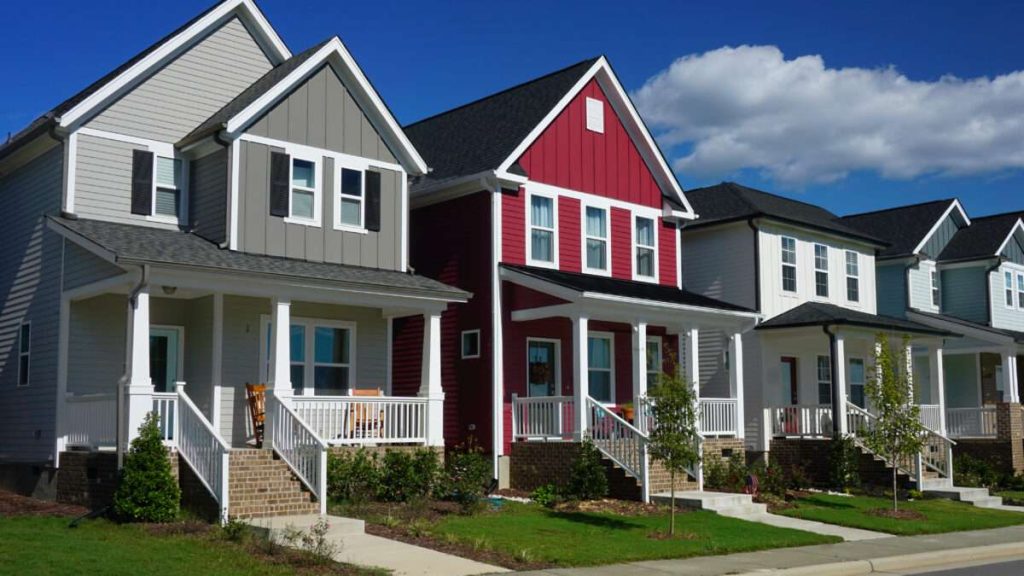Happy Tuesday, and welcome to another edition of Rent Free. This week’s stories include:
- Internal panic at the Department of Housing and Urban Development over DOGE cuts to staff and programs.
- Karen Bass’ resurfaced comments on how she successfully abused the California Environmental Equality Act (CEQA) provide a teachable moment in the difficulties of reform.
But first, we take a look at efforts in the California and Arizona legislatures to pass bills peeling back local regulations on small-lot, affordable starter homes.
New California Bill Attempts To Get Light-Touch Density Right
In 2021, the California Legislature passed the high-profile, much-praised Senate Bill 9, which effectively ended single-family-only zoning statewide.
The new law required local governments to “ministerially” approve duplexes and the splitting of lots in single-family-zoned neighborhoods.
The hope was that by allowing property owners to divide up their land and build two units on each half without endless public hearings and bureaucratic reviews, the state would see a blossoming of once-permitted, more affordable “missing middle” development in high-cost, highly desirable neighborhoods.
Advocates talked about turning back the clock on decades of exclusionary zoning.
An analysis of an early version of S.B. 9 by the University of California Berkeley’s Terner Center estimated that the bill could reasonably be expected to enable the development of an additional 700,000 new homes.
The law went into effect in 2022. Three years in, the actual results of S.B. 9 have been far less productive than hoped. Yearly counts of S.B. 9 projects number in the dozens and hundreds, not in the thousands and tens of thousands.
Some analysts now describe the law as “symbolic.”
But this past week, the law’s original author state Sen. Scott Wiener (D–San Francisco) has introduced a new bill that attempts to incorporate lessons from the past three years of S.B. 9 implementation and the success of far more productive statewide accessory dwelling unit (ADU) reforms to really make duplex legalization work.
Poison Pills
S.B. 9 suffered from the two separate but related problems.
The law itself imposed several statewide “poison pill” conditions on S.B. 9 projects that limited their practicality. It also gave local governments a lot of flexibility in implementing the new law, which has enabled them to craft local poison pills of their own.
At the state level, property owners are required to live on a lot if they want to use S.B. 9 to subdivide it. Any new lot created by an S.B. 9 lot split must also be at least 40 percent of the size of the original undivided property.
Both provisions have a lot to prevent new starter home projects, says Nolan Gray, legislative director of California YIMBY (and occasional Reason contributor).
The law’s owner-occupancy requirement for lot splits largely excludes small-time developers (and the capital and expertise they can bring to the table) from using S.B. 9, he says. Then the size restrictions on newly created lots stop the straightforward type of lot split project an owner-occupier might do: carving off and selling the backyard of a large single-family lot.
The law also prevents S.B. 9 projects on properties where a renter has lived within the last three years, meaning a single-family rental home today can’t be converted into a rentable duplex tomorrow.
Local Resistance
The real undermining of S.B. 9 has happened at the local level. “It’s an all-you-can-eat buffet of local subversions with the law,” says Gray.
These subversions include highly prescriptive dimension standards for lot splits. Some cities have required that lot splits be done along straight lines, preventing flag lots or properties with curved edges. Other cities require that side lot lines be at right angles to the street or require each new lot abut a public road.
Local governments have also required that S.B. 9 projects include below-market-rate units or pay “inclusionary zoning” fees of $20,000 or more.
Localities often require S.B. 9 projects to pay large impact fees and meet strict landscaping standards. Cities have compounded their complex requirements with slow permitting processes.
That doesn’t even touch the more creative means local governments have used to undermine S.B. 9. Readers might remember the colorful case of Woodside, California, exempting itself from the law by declaring the entire city a protected mountain lion habitat.
Because S.B. 9’s streamlined approvals apply only to single-family-zoned districts, San Francisco attempted to eliminate single-family zoning on paper as a means of continuing to apply more restrictive discretionary approval processes to S.B. 9–type duplexes and lot splits.
Pitiful Results and Proposed Fixes
A report released yesterday by advocacy group YIMBY Law, and first reported by CalMatters, found that just 235 S.B. 9 projects were entitled in 2023, and only 110 projects (totaling 140 units) received the building permits needed to start construction.
Similarly, the San Francisco Chronicle reported on Friday that just 144 S.B. 9 applications have been filed in selected Bay Area cities from 2022 to 2024. As the Chronicle story notes, the Bay Area was supposed to be the area where S.B. 9 would prove most productive.
Enter S.B. 677, written by Wiener and sponsored by the Housing Action Coalition and California YIMBY, which attempts to cure many of S.B. 9’s deficiencies.
At the state level, it ends the owner-occupancy and lot size requirements for S.B. 9 lot splits. It also eliminates the prohibition of S.B. 9 projects on sites of current rental housing, if the rental housing in question has been damaged or destroyed in a natural disaster.
It also raises the size cap on units that must be ministerially approved under S.B. 9, from the current 800 square feet to 1,750 square feet.
The bill also cracks down on local poison bills by banning local governments from imposing affordability requirements on S.B. 9 projects, prohibiting dimension standards, limiting the type of impact fees that can be charged, and generally requiring that S.B. 9 projects be treated the same as other projects allowed in the same zoning district.
More troubling from a property rights perspective, the bill would prevent homeowner associations from placing private restrictions on S.B. 9 projects.
Lessons Learned
Gray notes that S.B. 9 has not only underperformed expectations, it’s also underperformed other types of state-led housing deregulation efforts, most notably ADU reform.
Starting in the 1980s, the California Legislature started passing what ended up being dozens of laws aimed at making it easier for homeowners to add an additional granny flat or in-law suite on their property.
It wasn’t until 2016 that these reforms really started to yield results. Now that they have, ADU liberalization has proven remarkably successful.
“Today ADUs account for about one-fourth of all housing built in California,” says Gray.
The general thrust of S.B. 677 is to provide ADU-style protections to S.B. 9 lot splits and duplexes.
The American Enterprise Institute estimates that California would see an additional 90,000 units produced each year if it allowed four units by right on residential properties, which S.B. 9’s lot split and duplex legalization purports to do.
The key to hitting that number is to keep reforms simple and remove as many poison pills as possible, says Tobias Peters, a housing researcher at AEI.
“If there are a hundred things that could stop this thing from taking off, if you clean up 99 but leave one in place, nothing is going to happen,” he says.
That was certainly the result of the initial few years of S.B. 9. The premise of S.B. 677 is that it will actually remove enough restrictions to yield meaningful results.
In Arizona, Another Stab at Starter Home Reform
In a surprising act of bipartisanship last year, Arizona legislators passed a “Starter Homes Act” that peeled away local regulations on the construction of smaller single-family homes.
In an equally surprising move, Democratic Gov. Katie Hobbs vetoed the bill in March 2024, citing concerns raised late in the game by the U.S. Department of Defense (DOD) that the bill would allow too much development near military bases and failed to explicitly incorporate sufficient fire safety standards.
This year, housing advocates are trying again.
Committees in both the House and Senate have approved duplicate versions of a new, slightly modified Starter Home Act. The Republican and Democratic caucuses in both chambers have also voted in support of the bills.
Both pieces of legislation would forbid local governments from imposing aesthetic and architectural design requirements on single-family homes that are not in historic districts. They would also prevent localities from creating minimum lot sizes of more than 1,500 square feet in new single-family subdivisions or imposing both minimum and maximum lot area coverage ratios for single-family homes.
“The households that entered into the homebuying market 20, 30, 40 years ago were typically families buying these smaller homes on smaller lots. We’ve made those homes illegal to build in the state of Arizona,” says Jake Hinman, a lobbyist with the Arizona Neighborhood Project, which is advocating for the starter home bills.
To address Hobbs’ stated concerns in her veto statement, the new starter home bills also exclude areas near military airports and facilities.
Whether that will be enough to prevent a second veto remains to be seen.
As The Atlantic reported back in September, the DOD letter sent to Hobbs opposing the 2024 Starter Home Act was requested by the City of Glendale.
Local governments and their tax-funded state-level lobbying association were the primary opponents of last year’s bill and refused to negotiate on it. In Arizona, local governments have a lot of sway with Democrats given Republicans’ long dominance at the state level.
The same collection of local governments, mayors, and their associated lobbyists are opposing this year’s bill. Supporters include homebuilder groups, architect associations, environmental groups, YIMBY activists, and free market groups like Americans for Prosperity and the Goldwater Institute.
This puts Hobbs in an awkward political position if a starter home bill does make it to her desk again. She can risk a politically unpopular veto of a housing supply bill in a state where home prices are on the rise. Or she can sign it over the opposition of politically powerful cities. Heavy is the head that lies the crown. Heavy lies the crown.
“We believe we’ve made significant concessions that have been raised to date,” says Hinman of this year’s starter home bills.
At HUD, Panic Over DOGE Cuts
The Washington Post has a new story on the fears within the U.S. Department of Housing and Urban Development (HUD) that coming cuts to staff inspired by the Department of Government Efficiency (DOGE) will harm the department’s crucial missions.
Grants to homeless service providers and green building subsidies have reportedly already been frozen or are likely to be cut. Staff cuts will reportedly cover employees working on disability access enforcement and public housing inspections and staff at the Federal Housing Administration, which offers subsidized mortgages and mortgage insurance.
Readers will have differing opinions on just how crucial or desirable HUD’s various functions are. If you believe local and state land use restrictions are the primary cause of the country’s housing shortage, any DOGE cuts to the department will have a marginal effect on housing access and affordability.
In Los Angeles, Mayor Karen Bass Provides a Teachable Lesson on the Difficulties of Removing Veto Points
An old, resurfaced podcast interview of Mayor Karen Bass discussing her first-hand experience using the California Environmental Quality Act (CEQA) to block projects on pretextual environmental grounds is making the rounds on social media.
CEQA requires that local governments study the environmental effects of discretionary approvals they give to new development projects. The law also gives third parties the right to sue over allegedly insufficient CEQA reviews.
The clip is from a 2023 podcast interview with Bass and Los Angeles Times reporters Liam Dillon and Ben Oreskes. They ask the mayor if CEQA needs reform given how the law has been used to block new housing projects.
As X poster Kevin Dalton highlights, the mayor agrees that the law can be abused and then recounts how she abused it in the 1990s to block liquor stores.
In an interview from January 2023 Karen Bass warns how the California Environmental Quality Act can be abused, then goes on to gleefully tell a story about how she abused CEQA in the 90’s…
“Like a lot of things, it can be abused. I mean I will tell you, at Community Coalition… pic.twitter.com/XFzdcuS4BA
— Kevin Dalton (@TheKevinDalton) February 23, 2025
Bass’ comments highlight the difficulty of reforming CEQA and other “veto points” in the housing production process. Even if everyone agrees that projects get unnecessarily stopped, most people still want the power to stop some things, sometimes.
Pretty succinct explanation of why CEQA is so hard to reform politically. Everyone wants the ability to say no to something, sometime. You can stuff the law full of exemptions, but doesn’t stop lawsuits, doesn’t prevent courts hollowing out exemptions. https://t.co/sAsor7oqQf
— Christian Britschgi (@christianbrits) February 24, 2025
As it happens, Wiener has a new bill attempting to put more teeth into housing exemptions built into CEQA.
Quick Links
- The aforementioned YIMBY Law report is an instructive, depressing mine of data and analysis of just how poorly many of California’s state-level zoning reforms have performed.
- New fire risk maps mean big changes for California homeowners, reports the San Francisco Chronicle.
- The Virginia Legislature passes some exceedingly modest housing reforms and kills other equally modest ones.
- Oregon lawmakers consider new limits on security deposits and screening fees.
- A California bill would ban landlords from charging pet fees.
The post Fresh Starts on Starter Homes appeared first on Reason.com.






